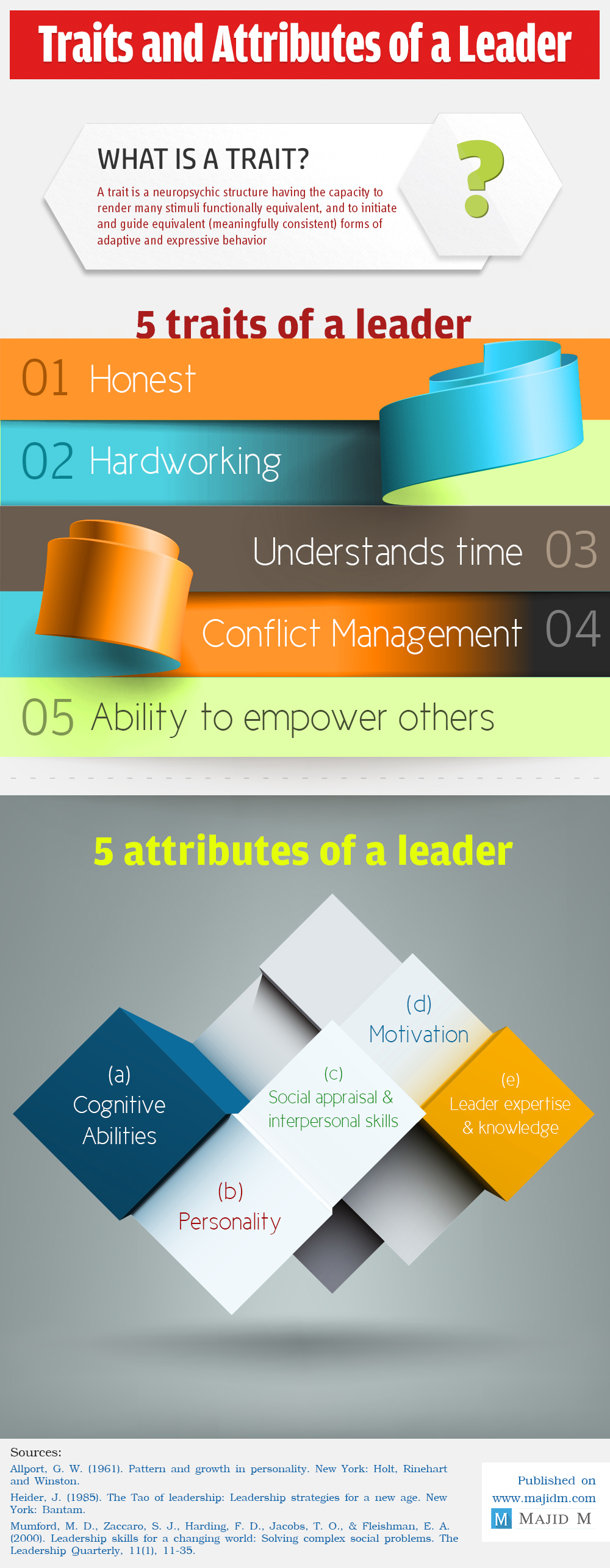Traits and attributes of a leader is not something that just got baked out of the oven, but has been out there for a long time. The example of Chinese Literature from the 6th century which was given by J. Heider, 1985 in “The Tao of Leadership” shows the Lao-tzu discussing the traits of a leader. Lao-tzu, introduced the wise leader as someone who was to be selfless, hardworking, honest, able to time the appropriateness of actions, fair in handling conflict, and able to “empower” others. In the famous book, Plato’s The Republic, the authors said that effective leaders in an ideal nation-state tend to use reasoning capacities and wisdom to lead others which is true as logic can give rise to a better capacity to understand and analyze the situations.
The students of Plato, Aristotle suggested that leaders were supposed to be virtuous and they were leaders for they could help others seek virtue. Bernard M Bass in his review suggests that leader qualities can be found in early Egyptians, Babylonian, Asian and Icelandic saga. The first empirical study of leadership was developed by Terman in 1904 which examined qualities to differentiate the leaders from the non-leaders in the audience of school children. From his empirical analysis, he reported attributes such as verbal fluency, intelligence, low emotionality, daring, being good, liveliness and congeniality as characterizing youth leaders. An interesting aspect that Muchinsky brought up in 1983 suggested that there is no point of connection between personality traits and leader effectiveness.
What is Trait?
One of the historical definitions of traits comes by Allport in 1961 who suggested “a trait is a neuropsychic structure having the capacity to render many stimuli functionally equivalent, and to initiate and guide equivalent (meaningfully consistent) forms of adaptive and expressive behavior”. Allport does seem to highlight the ideology that traits refer to stable patterns of behavior that are immune to changes in situations.
What are the Attributes of a Leader?
Mumford, Zaccaro, Harding, Jacobs, and Fleishman in the year 2000 suggested five categories of leader attributes which include (a) cognitive abilities, (b) personality, (c) motivation, (d) social appraisal and interpersonal skills, and (e) leader expertise and tacit knowledge.
-
Cognitive abilities
Cognitive abilities are the brain skills that are normally required to carry out the simplest or the most complex task. The cognitive ability tends to deal with the mechanisms of learning, remembering, problem-solving and paying attention rather than the knowledge base itself. In the research by Ferentinos in 1996, Ferentinos suggested that there was a strong correlation between general intelligence and leader emergence score. In another research by Spreitzer, McCall and Mahony in 1997 who suggested that there is a significant association between analytical ability and the ratings of executive potential as well as current managerial performance.
A study done by Mumford, Scott, Gaddis, & Strange in the year 2002 suggested that creative and divergent thinking is an important leader trait and can be a helping assistant in an organizational context which involves complex problem solving. Baehr had conducted an empirical research by taking a sample size of 1358 managers in firms from four different industries trying to associate the creative thinking with the position of executive; the results turned out that executives with higher ranks had a comparatively highly creative thinking power then middle or lower-level managers.
-
Personality
According to Digman who conducted research in 1990, Personality can be organized into five major categories including neuroticism, extroversion, openness to experience, agreeableness, and conscientiousness. Judge, Bono, Ilies and Gerhardt, in the year 2002 did a research and suggested that extroversion exhibited the strongest relationship to leadership which was followed by conscientiousness, neuroticism, and openness. The weakest relationship was observed by agreeableness.
-
Motivation
Motivation for leadership can come from different areas. Researchers have found that there can be some motives including: need for power or need for dominance, need for achievement, need for affiliation, and need for responsibility. Smith and Foti conducted a research in 1998 which has the result of need for dominances were positively associated, in conjunction with intelligence and self-efficacy, to leader emergence scores. Berman & Miner, in 1985 found that managerial motivation was linked with advancement and promotion.
-
Social appraisal and Interpersonal skills
Zaccaro, Gilbert, Thor, & Mumford, argued in 1992 that social appraisal skills, or social intelligence, reside at the heart of effective leadership. The reason for this comes from the definition of Social Intelligence which was presented by Marlowe in 1986, which was “Social Intelligence refers to the ability to understand the feelings, thoughts, and behaviors of persons, including oneself, in interpersonal situations and to act appropriately upon that understanding”. Clearly this indicates that a good leader has to be socially intelligent but social intelligence would be different for different regions. Hooijberg in 1996 also agreed to the fact that in a sample of business managers, behavioral flexibility was linked to leader effectiveness ratings.
-
Leader expertise and tacit knowledge
Mumford, Zaccaro and their team in the year 2000 discussed that leadership illustrates a form of solving social problems. This does indicate that a leader needs to be a capable problem solver. With an increase in experience of individuals, knowledge of that individual increases and the cognitive skills tend to improve resulting in an increased experience which allows to solve problems in a better way. The research team of Spreitzer in 1997, suggested that there is an ability in individuals to learn from experience which is an important leader quality.
In a nutshell, a successful leader does need to possess the five characteristics of leadership to become a better and wise leader. To be a better leader, you will have to be effective, emergent and need to know when to go further. The qualities like problem solving can be obtained by trying to engage one-self in finding the solution of problems and also working on improving the five characteristics. So you can definitely work your work towards becoming a leader. Check the infographic below which is a summary of the traits and attributes of a leader.

Share this Image On Your Site
Sources:
Allport, G. W. (1961). Pattern and growth in personality. New York: Holt, Rinehart and Winston.
Baehr, M. E. (1987). A review of employee evaluation procedures and a description of “high potential” executives and professionals. Journal of Business and Psychology, 1(3), 172-202.
Bass, B. M. (1985). Leadership and performance beyond expectations. Free Press; Collier Macmillan.
Berman, F. E., & Miner, J. B. (1985). Motivation to Manage at the Top Executive Level: A Test of the Hierarchic Role‐Motivation Theory. Personnel Psychology, 38(2), 377-391.
Digman, J. M. (1990). Personality structure: Emergence of the five-factor model. Annual review of psychology, 41(1), 417-440.
Ferentinos, C. H. (1996). Linking social intelligence and leadership: An investigation of leaders’ situational responsiveness under conditions of changing group tasks and membership (Doctoral dissertation, ProQuest Information & Learning).
Ferrari, G. R., & Griffith, T. (2000). Plato:’The Republic’. Cambridge University Press.
Heider, J. (1985). The Tao of leadership: Leadership strategies for a new age. New York: Bantam.
Hooijberg, R. (1996). A multidirectional approach toward leadership: An extension of the concept of behavioral complexity. Human Relations, 49(7), 917-946.
Judge, T. A., Bono, J. E., Ilies, R., & Gerhardt, M. W. (2002). Personality and leadership: a qualitative and quantitative review. Journal of applied psychology, 87(4), 765.
Marlowe, H. A. (1986). Social intelligence: Evidence for multidimensionality and construct independence. Journal of educational psychology, 78(1), 52.
Mumford, M. D., Scott, G. M., Gaddis, B., & Strange, J. M. (2002). Leading creative people: Orchestrating expertise and relationships. The leadership quarterly, 13(6), 705-750.
Mumford, M. D., Zaccaro, S. J., Harding, F. D., Jacobs, T. O., & Fleishman, E. A. (2000). Leadership skills for a changing world: Solving complex social problems. The Leadership Quarterly, 11(1), 11-35.
Muchinsky, P. M. (1983). Psychology applied to work. Homewood, IL: Dorsey Press
O’Connor, J., Mumford, M. D., Clifton, T. C., Gessner, T. L., & Connelly, M. S. (1996). Charismatic leaders and destructiveness: An historiometric study. The Leadership Quarterly, 6(4), 529-555
Quinn, R. E., & Spreitzer, G. M. (1997). The road to empowerment: Seven questions every leader should consider. organizational Dynamics, 26(2), 37-49.
Smith, J. A., & Foti, R. J. (1998). A pattern approach to the study of leader emergence. The Leadership Quarterly, 9(2), 147-160.
Spreitzer, G. M., McCall, M. W., & Mahoney, J. D. (1997). Early identification of international executive potential. Journal of Applied Psychology, 82(1), 6.
Terman, L. M. (1904). A preliminary study in the psychology and pedagogy of leadership. The Pedagogical Seminary, 11(4), 413-483.
Zaccaro, S. J., Gilbert, J. A., Thor, K. K., & Mumford, M. D. (1992). Leadership and social intelligence: Linking social perspectiveness and behavioral flexibility to leader effectiveness. The Leadership Quarterly, 2(4), 317-342.






